外研版(三年级起点)小学英语连词成句技巧及练习(无答案)
文档属性
| 名称 | 外研版(三年级起点)小学英语连词成句技巧及练习(无答案) | 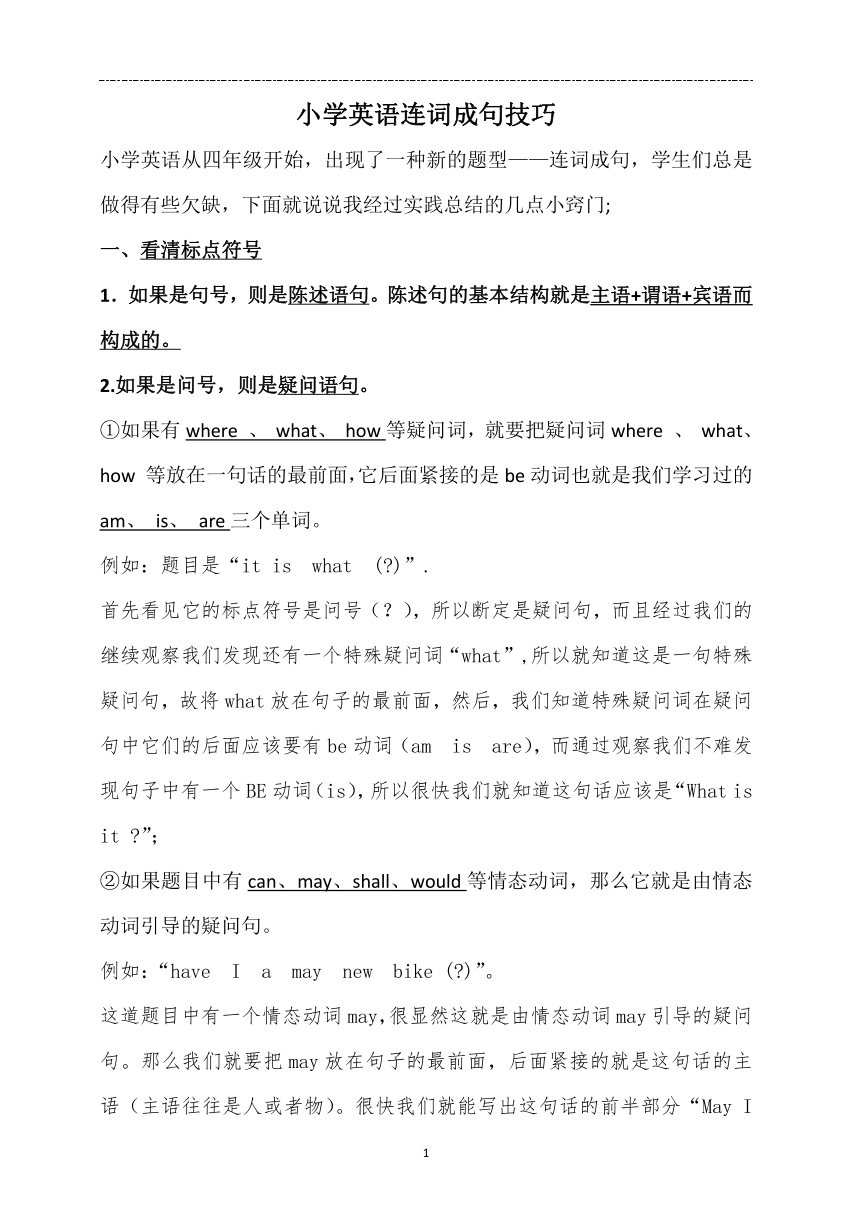 | |
| 格式 | zip | ||
| 文件大小 | 27.6KB | ||
| 资源类型 | 教案 | ||
| 版本资源 | 外研版(三年级起点) | ||
| 科目 | 英语 | ||
| 更新时间 | 2017-04-12 16:16:39 | ||
图片预览

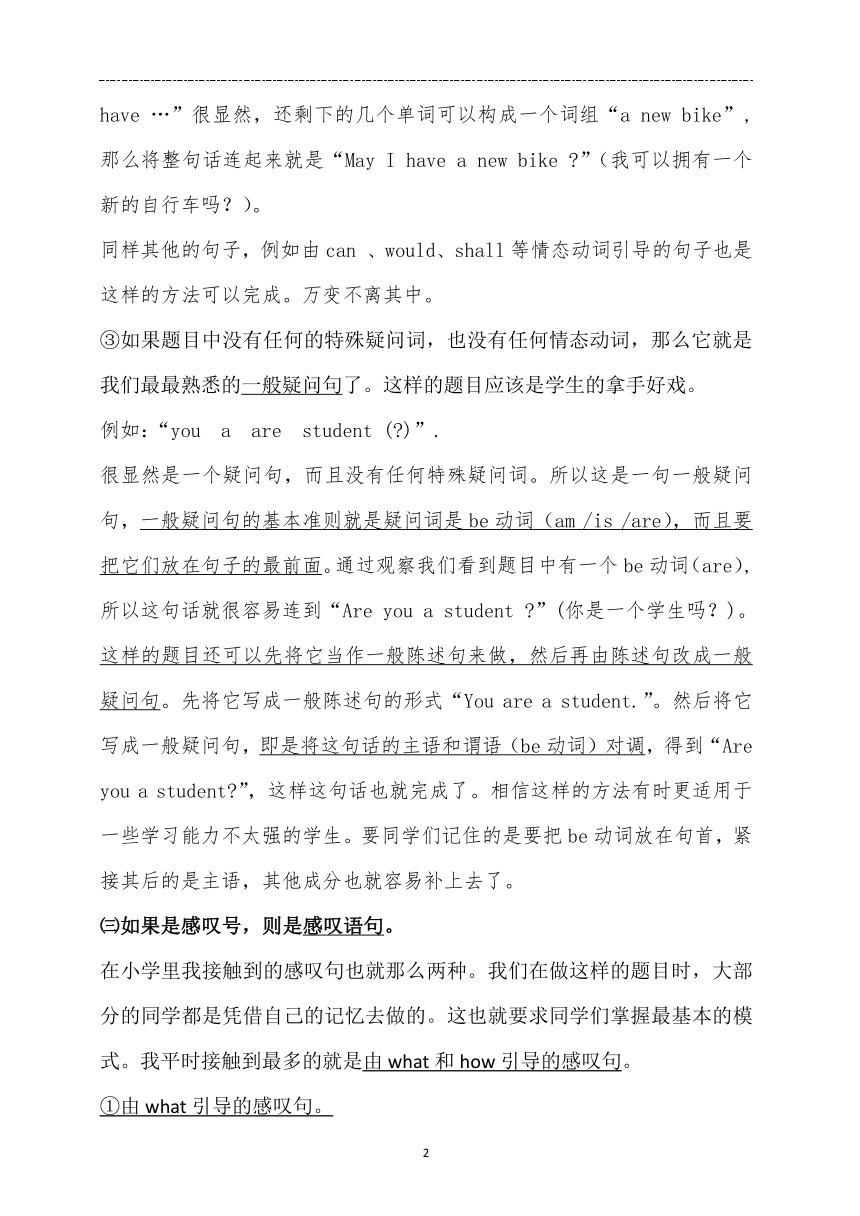
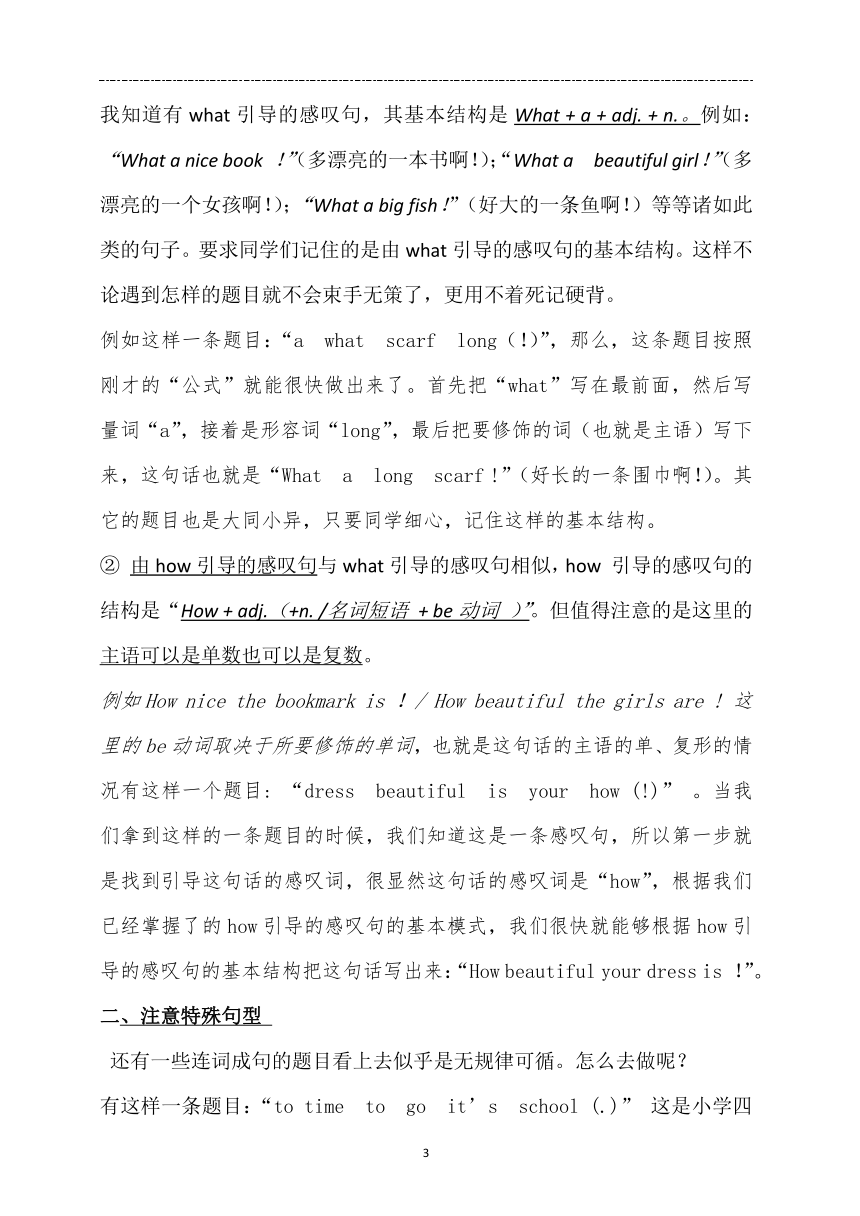
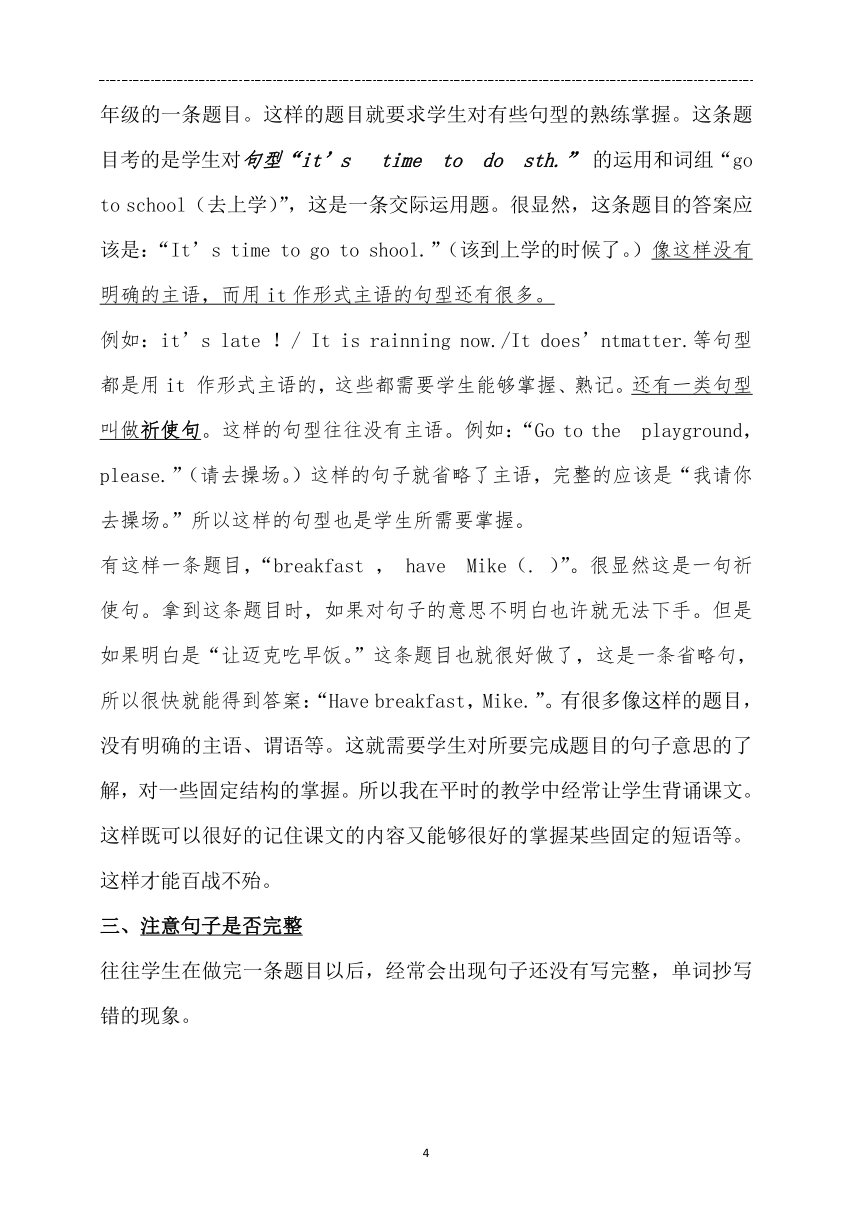
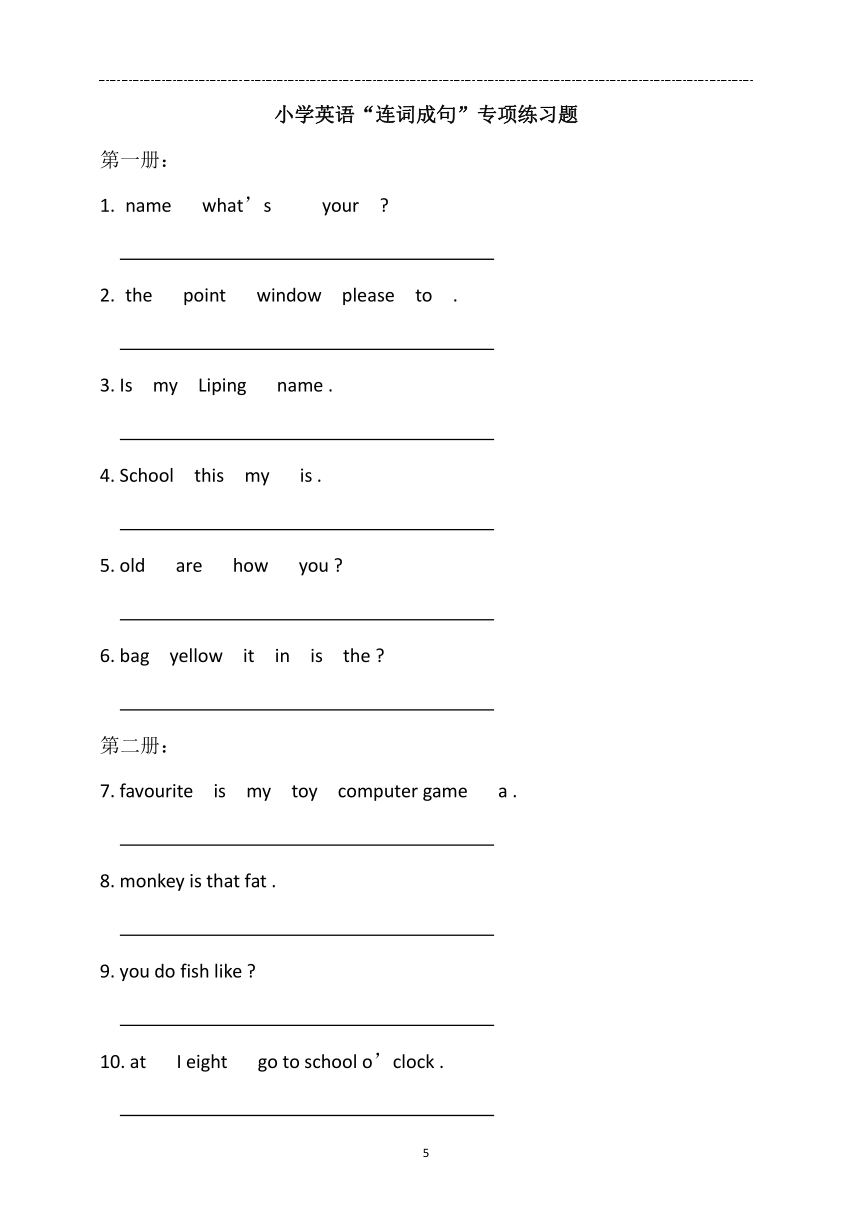
文档简介
小学英语连词成句技巧
小学英语从四年级开始,出现了一种新的题型——连词成句,学生们总是做得有些欠缺,下面就说说我经过实践总结的几点小窍门;
一、看清标点符号
1.如果是句号,则是陈述语句。陈述句的基本结构就是主语+谓语+宾语而构成的。
2.如果是问号,则是疑问语句。
①如果有where
、
what、
how等疑问词,就要把疑问词where
、
what、
how
等放在一句话的最前面,它后面紧接的是be动词也就是我们学习过的am、
is、
are三个单词。
例如:题目是“it
is
what
( )”.
首先看见它的标点符号是问号(?),所以断定是疑问句,而且经过我们的继续观察我们发现还有一个特殊疑问词“what”,所以就知道这是一句特殊疑问句,故将what放在句子的最前面,然后,我们知道特殊疑问词在疑问句中它们的后面应该要有be动词(am
is
are),而通过观察我们不难发现句子中有一个BE动词(is),所以很快我们就知道这句话应该是“What
is
it
”;
②如果题目中有can、may、shall、would等情态动词,那么它就是由情态动词引导的疑问句。
例如:“have
I
a
may
new
bike
( )”。
这道题目中有一个情态动词may,很显然这就是由情态动词may引导的疑问句。那么我们就要把may放在句子的最前面,后面紧接的就是这句话的主语(主语往往是人或者物)。很快我们就能写出这句话的前半部分“May
I
have
…”很显然,还剩下的几个单词可以构成一个词组“a
new
bike”,那么将整句话连起来就是“May
I
have
a
new
bike
”(我可以拥有一个新的自行车吗?)。
同样其他的句子,例如由can
、would、shall等情态动词引导的句子也是这样的方法可以完成。万变不离其中。
③如果题目中没有任何的特殊疑问词,也没有任何情态动词,那么它就是我们最最熟悉的一般疑问句了。这样的题目应该是学生的拿手好戏。
例如:“you
a
are
student
( )”.
很显然是一个疑问句,而且没有任何特殊疑问词。所以这是一句一般疑问句,一般疑问句的基本准则就是疑问词是be动词(am
/is
/are),而且要把它们放在句子的最前面。通过观察我们看到题目中有一个be动词(are),所以这句话就很容易连到“Are
you
a
student
”(你是一个学生吗?)。这样的题目还可以先将它当作一般陈述句来做,然后再由陈述句改成一般疑问句。先将它写成一般陈述句的形式“You
are
a
student.”。然后将它写成一般疑问句,即是将这句话的主语和谓语(be动词)对调,得到“Are
you
a
student ”,这样这句话也就完成了。相信这样的方法有时更适用于一些学习能力不太强的学生。要同学们记住的是要把be动词放在句首,紧接其后的是主语,其他成分也就容易补上去了。
㈢如果是感叹号,则是感叹语句。
在小学里我接触到的感叹句也就那么两种。我们在做这样的题目时,大部分的同学都是凭借自己的记忆去做的。这也就要求同学们掌握最基本的模式。我平时接触到最多的就是由what和how引导的感叹句。
①由what引导的感叹句。
我知道有what引导的感叹句,其基本结构是What
+
a
+
adj.
+
n.。例如:“What
a
nice
book
!”(多漂亮的一本书啊!);“What
a
beautiful
girl!”(多漂亮的一个女孩啊!);“What
a
big
fish!”(好大的一条鱼啊!)等等诸如此类的句子。要求同学们记住的是由what引导的感叹句的基本结构。这样不论遇到怎样的题目就不会束手无策了,更用不着死记硬背。
例如这样一条题目:“a
what
scarf
long(!)”,那么,这条题目按照刚才的“公式”就能很快做出来了。首先把“what”写在最前面,然后写量词“a”,接着是形容词“long”,最后把要修饰的词(也就是主语)写下来,这句话也就是“What
a
long
scarf
!”(好长的一条围巾啊!)。其它的题目也是大同小异,只要同学细心,记住这样的基本结构。
②
由how引导的感叹句与what引导的感叹句相似,how
引导的感叹句的结构是“How
+
adj.(+n.
/名词短语
+
be动词
)”。但值得注意的是这里的主语可以是单数也可以是复数。
例如How
nice
the
bookmark
is
!/
How
beautiful
the
girls
are
!
这里的be动词取决于所要修饰的单词,也就是这句话的主语的单、复形的情况有这样一个题目:
“dress
beautiful
is
your
how
(!)”
。当我们拿到这样的一条题目的时候,我们知道这是一条感叹句,所以第一步就是找到引导这句话的感叹词,很显然这句话的感叹词是“how”,根据我们已经掌握了的how引导的感叹句的基本模式,我们很快就能够根据how引导的感叹句的基本结构把这句话写出来:“How
beautiful
your
dress
is
!”。
二、注意特殊句型
还有一些连词成句的题目看上去似乎是无规律可循。怎么去做呢?
有这样一条题目:“to
time
to
go
it’s
school
(.)”
这是小学四年级的一条题目。这样的题目就要求学生对有些句型的熟练掌握。这条题目考的是学生对句型“it’s
time
to
do
sth.”
的运用和词组“go
to
school(去上学)”,这是一条交际运用题。很显然,这条题目的答案应该是:“It’s
time
to
go
to
shool.”(该到上学的时候了。)像这样没有明确的主语,而用it作形式主语的句型还有很多。
例如:it’s
late
!/
It
is
rainning
now./It
does’ntmatter.等句型都是用it
作形式主语的,这些都需要学生能够掌握、熟记。还有一类句型叫做祈使句。这样的句型往往没有主语。例如:“Go
to
the
playground,please.”(请去操场。)这样的句子就省略了主语,完整的应该是“我请你去操场。”所以这样的句型也是学生所需要掌握。
有这样一条题目,“breakfast
,
have
Mike(.
)”。很显然这是一句祈使句。拿到这条题目时,如果对句子的意思不明白也许就无法下手。但是如果明白是“让迈克吃早饭。”这条题目也就很好做了,这是一条省略句,所以很快就能得到答案:“Have
breakfast,Mike.”。有很多像这样的题目,没有明确的主语、谓语等。这就需要学生对所要完成题目的句子意思的了解,对一些固定结构的掌握。所以我在平时的教学中经常让学生背诵课文。这样既可以很好的记住课文的内容又能够很好的掌握某些固定的短语等。这样才能百战不殆。
注意句子是否完整
往往学生在做完一条题目以后,经常会出现句子还没有写完整,单词抄写错的现象。
小学英语“连词成句”专项练习题
第一册:
name
what’s
your
the
point
window
please
to
.
3.
Is
my
Liping
name
.
4.
School
this
my
is
.
5.
old
are
how
you
6.
bag
yellow
it
in
is
the
第二册:
7.
favourite
is
my
toy
computer
game
a
.
8.
monkey
is
that
fat
.
9.
you
do
fish
like
10.
at
I
eight
go
to
school
o’clock
.
11.
time
the
what’s
please
12.
have
at
I
dinner
half
seven
past
.
13.
the
you
what
do
do
at
weekend
14.
family
we
dinner
a
have
a
big
.
15.
Sam
got
sweater
a
has
new
16.
goes
by
school
to
Amy
bike
.
第三册:
17.
got
elephant
you
have
an
18.
No.
2
where
West
Lake
Road
please
is
19.
friend
to
she’s
talking
her
.
20.
girls
the
what
drinking
are
21.
want
you
noodles
do
some
22.
you
England
got
have
in
chopsticks
29.
you
fast
can
run
30.
you
fast
can
run
.
31.
are
Beijing
tomorrow
going
to
we
to
go
.
32.
birthdays
three
May
in
there
are
.
第四册:
33.
capital
London
England
of
the
is
the
.
34.
Friday
I
my
will
on
visit
grandma
.
35.
it
Beijing
be
will
windy
in
36.
Beijing
bigger
Tianjin
than
is
.
37.
east
in
Qingdao
the
of
is
China
.
38.
Daming
watermelons
two
had
yesterday
.
第五册:
39.
came
last
we
back
Sunday
.
40.
oranges
how
many
want
you
do
41.
you
milk
want
how
much
do
42.
do
what
did
weekend
the
you
at
43.
hers
bag
is
this
.
44.
ten
there
are
blue
the
box
pencils
in
.
45.
do
can
very
you
it
well
.
46.
time
you
do
get
up
what
47.
at
I
past
half
get
up
seven
.
48.
should
you
road
the
cross
look
then
.
第六册:
49.
weren’t
buses
there
any
.
50.
your
did
learn
grandpa
English
51.
for
what
she
have
breakfast
did
52.
are
the
computers
where
about
books
please
53.
can
where
found
out
animals
about
you
54.
blue
the
big
light
and
one
.
55.
too
you
big
for
it’s
.
56.
did
go
when
Xinjiang
you
to
57.
let’s
email
dad
to
send
an
.
58.
will
home
seven
I
o’clock
be
at
.
59.
don’t
you
why
kite
give
a
him
60.
about
dragon
how
kite
a
61.
a
lot
laughed
we
.
62.
airport
who’s
going
go
to
the
to
第七册:
63.
me
about
Great
Wall
the
more
.
lots
of
shops
there
are
there
Chinese
.
65.
stamps
some
these
from
are
Canada
.
66.
China
stamps
have
any
got
from
you
67.
tell
more
American
can
festival
you
me
about
68.
address
this
in
my
China
is
.
69.
has
a
kite
Chinese
got
and
Daming
fly
we
park
it
the
in
.
70.
eat
pandas
twelve
day
hours
a
for
eat
.
71.
now
you
like
do
books
reading
72.
clean
do
room
often
you
your
73.
want
Daming
show
to
I
present
China
from
the
.
74.
talk
don’t
the
library
in
.
第八册:
75.
you
do
want
what
eat
to
76.
going
to
we’re
picnic
park
the
have
in
a
.
77.
it’s
snow
Harbin
going
to
in
.
78.
birds
singing
trees
in
the
the
are
.
79.
balloons
flying
the
away
are
.
80.
apples
falling
stairs
are
the
the
down
.
81.
he’s
dinner
but
phone
eating
is
the
ringing
.
82.
bought
book
I
you
this
.
83.
gave
you
it
who
to
84.
Shenzhou
V
Yang
Liwei
into
flew
with
space
.
85.
made
video
he
and
famous
he
now
very
a
is
.
86.
about
she
book
herself
wrote
a
.
87.
have
why
got
heads
got
on
cups
you
88.
going
to
Chinese
we
speak
are
.
89.
you
middle
school
September
are
going
to
to
this
go
they
what
going
to
are
nine
do
at
小学英语从四年级开始,出现了一种新的题型——连词成句,学生们总是做得有些欠缺,下面就说说我经过实践总结的几点小窍门;
一、看清标点符号
1.如果是句号,则是陈述语句。陈述句的基本结构就是主语+谓语+宾语而构成的。
2.如果是问号,则是疑问语句。
①如果有where
、
what、
how等疑问词,就要把疑问词where
、
what、
how
等放在一句话的最前面,它后面紧接的是be动词也就是我们学习过的am、
is、
are三个单词。
例如:题目是“it
is
what
( )”.
首先看见它的标点符号是问号(?),所以断定是疑问句,而且经过我们的继续观察我们发现还有一个特殊疑问词“what”,所以就知道这是一句特殊疑问句,故将what放在句子的最前面,然后,我们知道特殊疑问词在疑问句中它们的后面应该要有be动词(am
is
are),而通过观察我们不难发现句子中有一个BE动词(is),所以很快我们就知道这句话应该是“What
is
it
”;
②如果题目中有can、may、shall、would等情态动词,那么它就是由情态动词引导的疑问句。
例如:“have
I
a
may
new
bike
( )”。
这道题目中有一个情态动词may,很显然这就是由情态动词may引导的疑问句。那么我们就要把may放在句子的最前面,后面紧接的就是这句话的主语(主语往往是人或者物)。很快我们就能写出这句话的前半部分“May
I
have
…”很显然,还剩下的几个单词可以构成一个词组“a
new
bike”,那么将整句话连起来就是“May
I
have
a
new
bike
”(我可以拥有一个新的自行车吗?)。
同样其他的句子,例如由can
、would、shall等情态动词引导的句子也是这样的方法可以完成。万变不离其中。
③如果题目中没有任何的特殊疑问词,也没有任何情态动词,那么它就是我们最最熟悉的一般疑问句了。这样的题目应该是学生的拿手好戏。
例如:“you
a
are
student
( )”.
很显然是一个疑问句,而且没有任何特殊疑问词。所以这是一句一般疑问句,一般疑问句的基本准则就是疑问词是be动词(am
/is
/are),而且要把它们放在句子的最前面。通过观察我们看到题目中有一个be动词(are),所以这句话就很容易连到“Are
you
a
student
”(你是一个学生吗?)。这样的题目还可以先将它当作一般陈述句来做,然后再由陈述句改成一般疑问句。先将它写成一般陈述句的形式“You
are
a
student.”。然后将它写成一般疑问句,即是将这句话的主语和谓语(be动词)对调,得到“Are
you
a
student ”,这样这句话也就完成了。相信这样的方法有时更适用于一些学习能力不太强的学生。要同学们记住的是要把be动词放在句首,紧接其后的是主语,其他成分也就容易补上去了。
㈢如果是感叹号,则是感叹语句。
在小学里我接触到的感叹句也就那么两种。我们在做这样的题目时,大部分的同学都是凭借自己的记忆去做的。这也就要求同学们掌握最基本的模式。我平时接触到最多的就是由what和how引导的感叹句。
①由what引导的感叹句。
我知道有what引导的感叹句,其基本结构是What
+
a
+
adj.
+
n.。例如:“What
a
nice
book
!”(多漂亮的一本书啊!);“What
a
beautiful
girl!”(多漂亮的一个女孩啊!);“What
a
big
fish!”(好大的一条鱼啊!)等等诸如此类的句子。要求同学们记住的是由what引导的感叹句的基本结构。这样不论遇到怎样的题目就不会束手无策了,更用不着死记硬背。
例如这样一条题目:“a
what
scarf
long(!)”,那么,这条题目按照刚才的“公式”就能很快做出来了。首先把“what”写在最前面,然后写量词“a”,接着是形容词“long”,最后把要修饰的词(也就是主语)写下来,这句话也就是“What
a
long
scarf
!”(好长的一条围巾啊!)。其它的题目也是大同小异,只要同学细心,记住这样的基本结构。
②
由how引导的感叹句与what引导的感叹句相似,how
引导的感叹句的结构是“How
+
adj.(+n.
/名词短语
+
be动词
)”。但值得注意的是这里的主语可以是单数也可以是复数。
例如How
nice
the
bookmark
is
!/
How
beautiful
the
girls
are
!
这里的be动词取决于所要修饰的单词,也就是这句话的主语的单、复形的情况有这样一个题目:
“dress
beautiful
is
your
how
(!)”
。当我们拿到这样的一条题目的时候,我们知道这是一条感叹句,所以第一步就是找到引导这句话的感叹词,很显然这句话的感叹词是“how”,根据我们已经掌握了的how引导的感叹句的基本模式,我们很快就能够根据how引导的感叹句的基本结构把这句话写出来:“How
beautiful
your
dress
is
!”。
二、注意特殊句型
还有一些连词成句的题目看上去似乎是无规律可循。怎么去做呢?
有这样一条题目:“to
time
to
go
it’s
school
(.)”
这是小学四年级的一条题目。这样的题目就要求学生对有些句型的熟练掌握。这条题目考的是学生对句型“it’s
time
to
do
sth.”
的运用和词组“go
to
school(去上学)”,这是一条交际运用题。很显然,这条题目的答案应该是:“It’s
time
to
go
to
shool.”(该到上学的时候了。)像这样没有明确的主语,而用it作形式主语的句型还有很多。
例如:it’s
late
!/
It
is
rainning
now./It
does’ntmatter.等句型都是用it
作形式主语的,这些都需要学生能够掌握、熟记。还有一类句型叫做祈使句。这样的句型往往没有主语。例如:“Go
to
the
playground,please.”(请去操场。)这样的句子就省略了主语,完整的应该是“我请你去操场。”所以这样的句型也是学生所需要掌握。
有这样一条题目,“breakfast
,
have
Mike(.
)”。很显然这是一句祈使句。拿到这条题目时,如果对句子的意思不明白也许就无法下手。但是如果明白是“让迈克吃早饭。”这条题目也就很好做了,这是一条省略句,所以很快就能得到答案:“Have
breakfast,Mike.”。有很多像这样的题目,没有明确的主语、谓语等。这就需要学生对所要完成题目的句子意思的了解,对一些固定结构的掌握。所以我在平时的教学中经常让学生背诵课文。这样既可以很好的记住课文的内容又能够很好的掌握某些固定的短语等。这样才能百战不殆。
注意句子是否完整
往往学生在做完一条题目以后,经常会出现句子还没有写完整,单词抄写错的现象。
小学英语“连词成句”专项练习题
第一册:
name
what’s
your
the
point
window
please
to
.
3.
Is
my
Liping
name
.
4.
School
this
my
is
.
5.
old
are
how
you
6.
bag
yellow
it
in
is
the
第二册:
7.
favourite
is
my
toy
computer
game
a
.
8.
monkey
is
that
fat
.
9.
you
do
fish
like
10.
at
I
eight
go
to
school
o’clock
.
11.
time
the
what’s
please
12.
have
at
I
dinner
half
seven
past
.
13.
the
you
what
do
do
at
weekend
14.
family
we
dinner
a
have
a
big
.
15.
Sam
got
sweater
a
has
new
16.
goes
by
school
to
Amy
bike
.
第三册:
17.
got
elephant
you
have
an
18.
No.
2
where
West
Lake
Road
please
is
19.
friend
to
she’s
talking
her
.
20.
girls
the
what
drinking
are
21.
want
you
noodles
do
some
22.
you
England
got
have
in
chopsticks
29.
you
fast
can
run
30.
you
fast
can
run
.
31.
are
Beijing
tomorrow
going
to
we
to
go
.
32.
birthdays
three
May
in
there
are
.
第四册:
33.
capital
London
England
of
the
is
the
.
34.
Friday
I
my
will
on
visit
grandma
.
35.
it
Beijing
be
will
windy
in
36.
Beijing
bigger
Tianjin
than
is
.
37.
east
in
Qingdao
the
of
is
China
.
38.
Daming
watermelons
two
had
yesterday
.
第五册:
39.
came
last
we
back
Sunday
.
40.
oranges
how
many
want
you
do
41.
you
milk
want
how
much
do
42.
do
what
did
weekend
the
you
at
43.
hers
bag
is
this
.
44.
ten
there
are
blue
the
box
pencils
in
.
45.
do
can
very
you
it
well
.
46.
time
you
do
get
up
what
47.
at
I
past
half
get
up
seven
.
48.
should
you
road
the
cross
look
then
.
第六册:
49.
weren’t
buses
there
any
.
50.
your
did
learn
grandpa
English
51.
for
what
she
have
breakfast
did
52.
are
the
computers
where
about
books
please
53.
can
where
found
out
animals
about
you
54.
blue
the
big
light
and
one
.
55.
too
you
big
for
it’s
.
56.
did
go
when
Xinjiang
you
to
57.
let’s
dad
to
send
an
.
58.
will
home
seven
I
o’clock
be
at
.
59.
don’t
you
why
kite
give
a
him
60.
about
dragon
how
kite
a
61.
a
lot
laughed
we
.
62.
airport
who’s
going
go
to
the
to
第七册:
63.
me
about
Great
Wall
the
more
.
lots
of
shops
there
are
there
Chinese
.
65.
stamps
some
these
from
are
Canada
.
66.
China
stamps
have
any
got
from
you
67.
tell
more
American
can
festival
you
me
about
68.
address
this
in
my
China
is
.
69.
has
a
kite
Chinese
got
and
Daming
fly
we
park
it
the
in
.
70.
eat
pandas
twelve
day
hours
a
for
eat
.
71.
now
you
like
do
books
reading
72.
clean
do
room
often
you
your
73.
want
Daming
show
to
I
present
China
from
the
.
74.
talk
don’t
the
library
in
.
第八册:
75.
you
do
want
what
eat
to
76.
going
to
we’re
picnic
park
the
have
in
a
.
77.
it’s
snow
Harbin
going
to
in
.
78.
birds
singing
trees
in
the
the
are
.
79.
balloons
flying
the
away
are
.
80.
apples
falling
stairs
are
the
the
down
.
81.
he’s
dinner
but
phone
eating
is
the
ringing
.
82.
bought
book
I
you
this
.
83.
gave
you
it
who
to
84.
Shenzhou
V
Yang
Liwei
into
flew
with
space
.
85.
made
video
he
and
famous
he
now
very
a
is
.
86.
about
she
book
herself
wrote
a
.
87.
have
why
got
heads
got
on
cups
you
88.
going
to
Chinese
we
speak
are
.
89.
you
middle
school
September
are
going
to
to
this
go
they
what
going
to
are
nine
do
at
